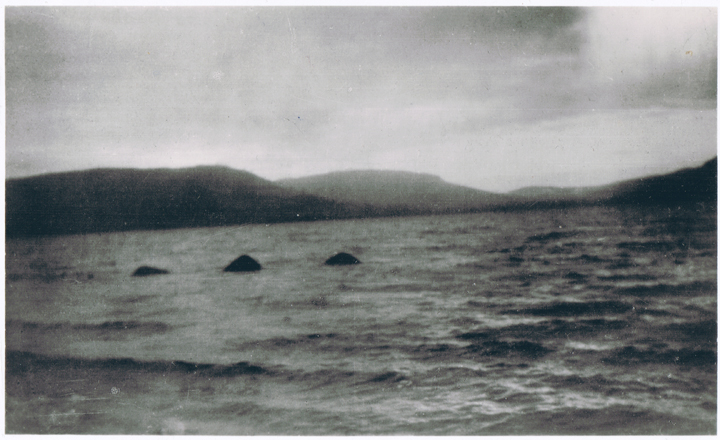
1. The Original story.
On Saturday 14th July 1951 Lachlan Stuart, a woodsman who worked for the Forestry Commission, had arisen at about 6:30 am to milk his cow on the croft he and his family occupied about 100 feet above Loch Ness at Whitefield, which is almost opposite Urquhart Castle. He glanced out of the window and saw something large moving out in the loch.
Calling out to his friend Mr Hay who was staying at the house he ran down quickly to the shore. In seconds Mr Hay was by his side and both watched fascinated as the huge creature approached displaying three separate triangular humps with water showing between each; moving at a fair speed it passed within 50 yards of the shore, and it was then that Mr Stewart (sic) who had grabbed a small box camera before he left the house, took a snapshot. (From "Loch Ness Monster", Tim Dinsdale, 1961, p51)

"Photo of the Loch Ness Monster taken by Mr L. Stuart on 14th July 1952*" from a contemporary postcard. (*sic)
2. The later revelation by Richard Frere of a hoax.
The photograph was published in the newspapers and found its way into the various books on the Loch Ness monster. In 1984 Richard Frere mentions the incident in his autobiography "Loch Ness", as follows:
"... I have no particular objection to hoaxers...and my chief reaction on getting first hand knowledge of the affair was surprise at how easily even experts can be duped. This amateurish invention was given the seal of approval by a leading zoologist as the "most important picture" (p169)"
and he gives an explanation and more detail in a letter to researcher Alastair Boyd, reproduced here from Rip Hepple's "Nessletter" No. 88, of June 1988:
"Dear Mr Boyd, thank you for your letter concerning Stuart's photograph of ?. As you say many years have gone by since 1951 but I happen to remember clearly a meeting at Loch Ness side, in the vicinity of the Whitefield cottage, with a man who represented himself as Lachlan Stuart. At that time I had a timber business and was in need of an additional horse for timber dragging. I had heard that Stuart had such a beast or could put me in touch with one and our meeting was arranged by a third party. I met with Stuart in early August. We discussed the horse but no bargain was struck, even after the woodsman had obligingly offered a dram from his bottle. Before we parted he took me down to the pebble beach, where, concealed within a clump of alder or hazel, I was shown on my promise of silence, three or four bales of hay (as supplied for horses) and some strips of tarpaulin. I was told that these were the "humps" of ?. S was proud of his joke, in which he saw no harm, and he was greatly surprised that his photograph had come out at all, as it was taken "near dark". I did not enquire at what margin of the day it had been snapped. Stuart considered ? 'a load of nonsense' and poked fun at those who took it seriously. From this you can see that I did not participate in the hoax, although, perhaps, my silence until recently may be construed as that of an accessory."
So in the autobiography he mentions the hoax while (mostly) respecting his promise to Lachlan Stuart, and in the later letter to Alastair Boyd he gives the full story of how he subsequently obtained "first hand knowledge" of the matter a few weeks later.
3. A Visit to Whitefield.
On 2nd September 2012 I visited the site. The camera location can be established quite accurately by the alignment of the hills on the far side of the loch, and up into Glen Urquhart. I had earlier put myself in LS's shoes and asked where would I carry out the photography? I have some bales of mouldy hay left over from the previous year that require disposal now that the new stock has arrived. These weigh at least 40 lb each. I put them on my vehicle at the byre behind my cottage and drive down the 400 metre track to the junction with the "main road". I then carry them the minimum distance, which is straight across the road and 30 metres down to the beach. The view from that spot matches the view shown in the 1951 photograph.
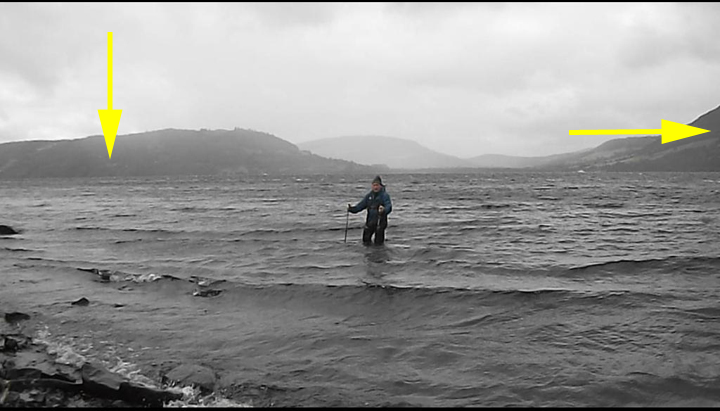
Above is a wide-angle view taken with a Fuji Finepix AX245W at the "widest zoom" setting, on a tripod 1.20 metres above water level. I have measured the view as being 57.6 degrees horizontally. The yellow arrow at the left marks the property named "Woodlands" , and the one on the right points to "Tychat". These are in my estimation the left and right limits of the 1951 photograph. Using GoogleEarth I measured the bearing of Tychat to be 292 degrees, and Woodlands to be 246 degrees. The horizontal angle of view in the 1951 photograph would therefore appear to be about (292 - 246) 46 degrees.
Lachlan Stuart is said to have used a "simple box camera", and this almost inevitably will have been an "8 on 120" type with a 90mm focal length lens giving a landscape format of 84mm x 56mm, i.e. 50 degrees by 33 degrees. This would look like the image below:
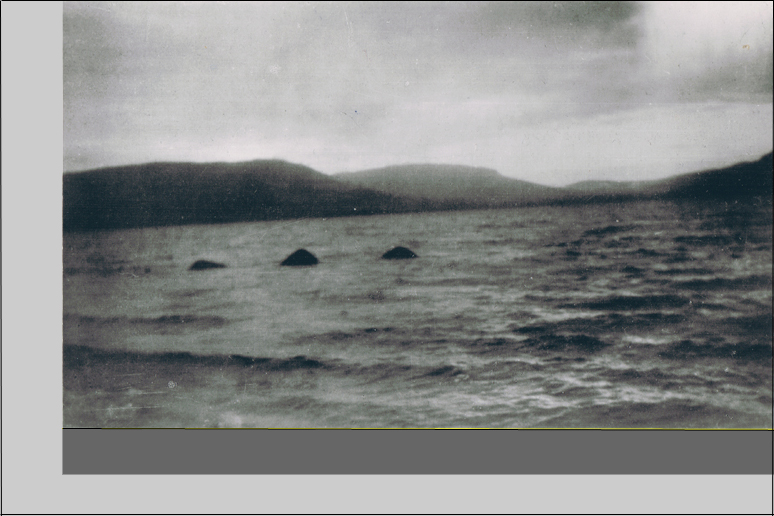
This suggests that a little image has been trimmed off the width, and more off the height. Two versions are shown here, the dark grey border at the bottom "almost certainly" was cut off, while the pale grey below and to the left "may" also have been cut off the original if it was originally 50 degrees by 33. It is possible that the photograph was trimmed by removing sky at the top of the photo, but in keeping with the spirit of the joke it makes more sense to remove the distracting beach in the foreground.
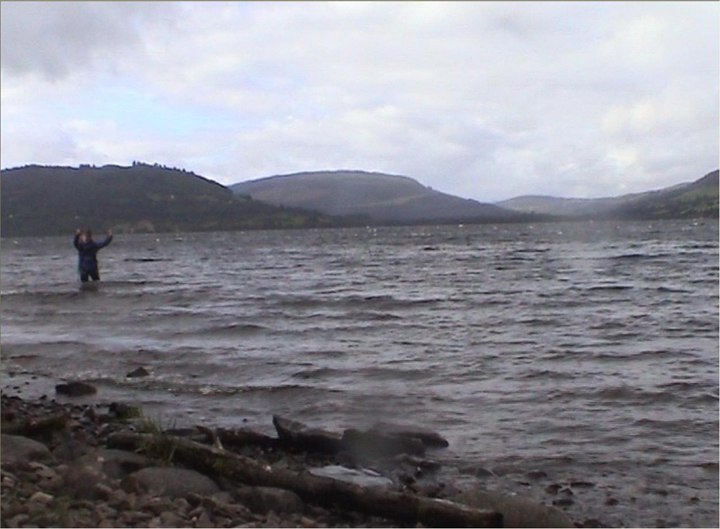
A modern photograph from close to the same location at NH55559 29661. A still frame taken with a
Sony DCR-TRV25E at "widest zoom" or shortest focal length setting, mounted about 75cm above water level.
Copyright Dick Raynor 2012 Right-click on the image, then select "play"
Above is a short sequence in which the images have been aligned and resized and merge into each other.
4. Tests with real bales of hay.
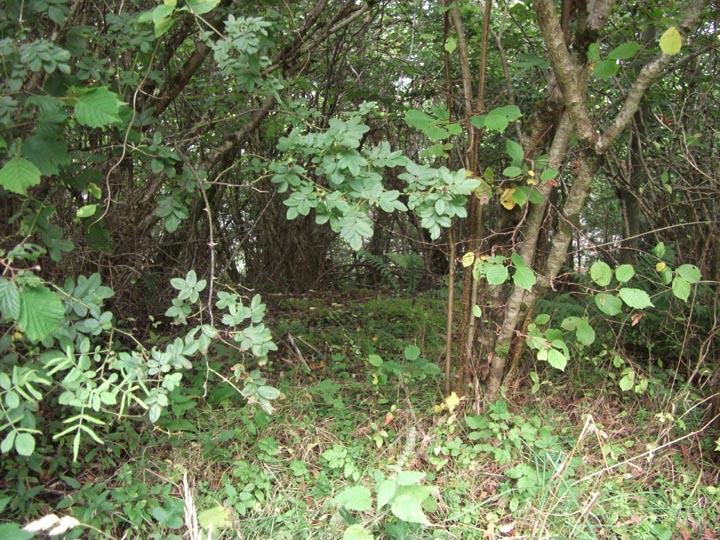
Looking towards the loch from the road...
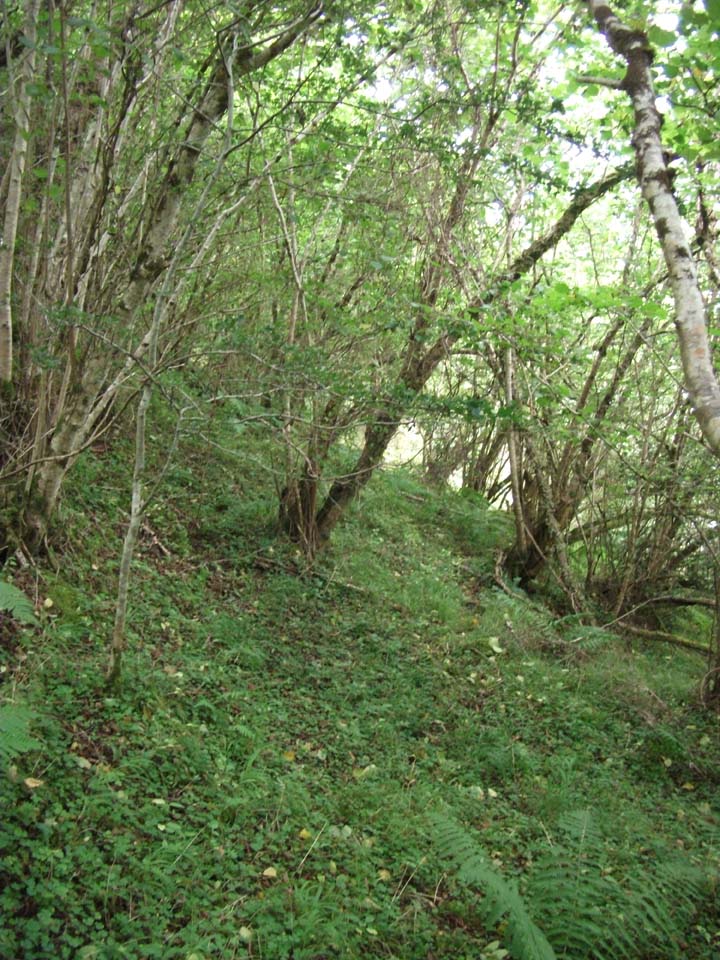
Part way down the bank.
Some days later, two bales of fresh hay were obtained and wrapped in black polythene sheeting, sealed with duct tape.
The sizes were approximately 40 x 50 x 100 cm and weighed between 20 and 25 kg. When initially launched they floated high in the water, consistent with their SG of around 0.13. Ballast stones were added and the plastic wrapping sheet was pierced to allow water into the bales, and after a few tens of minutes the bales better resembled the objects in the LS 1951 photograph, at which point some video recordings were made. It should be noted that this was not an attempt to replicate the Lachlan Stuart Photograph, but simply to demonstrate that Richard Frere's account of a conversation with Mr Stuart in which he confided that the photograph showed bales of hay was technically credible, and therefore the most likely explanation of the image offered to date. One photo is shown below, blended in with the LS 1951 photograph.
After some filming exercises the plastic wrapping sheets were removed from the bales at which point they fairly rapidly took on water until only around 10% of the volume was above the surface. The bales were then recovered to the beach where it was found impossible to move them with less than two strong people, but after a period of draining they were removed from the shoreline.
This exercise demonstrates to my satisfaction that Mr Richard Frere's account of Mr Lachlan Stuart's admission of a practical joke to be consistent with the observed distance from the shore, water depth, object size, shape and behaviour of hay bales and quite inconsistent with the original story.
The hay bale experiments were carried out jointly with the Loch Ness Project. It will be noticed that the lighting in our photographs matches quite well with the 1951 image, the water surface being a mixture of reflection and refraction (not shadows) and there is similarly poor detail in the hillsides opposite; this is to be expected in photos taken in the evening, consistent with Richard Frere's report that Lachlan Stuart had expressed surprise that the photo had come out at all, having been taken when it was "near dark".
Further supporting an evening photograph, one significant report appearing in Steuart Campbell's 1986 book* is that the film was developed by a commercial photographer who found that "the negative development took nearly twice the normal time". The man developing the film could not have known it needed extra development without looking at it during the process, and this knowledge surely points to the use of orthochromatic film, the only kind that one can inspect in red light during development due to its lack of sensitivity to that colour. Although it's name means "correct colour" it is far from perfect and is sensitive to ultra-violet, violet, blue and most of all to green light. It is not sensitive to oranges and reds beyond 590 nm. In morning light the green July hillside between Urquhart Bay and the left hand edge of the photograph should be filled with detail, but it is practically dark.
Mr Stuart's contemporary statements to the media imply that the photo was taken in the morning, which is clearly not the case, and was of a large creature moving at a fair speed, for which there is no evidence. Unfortunately neither the humps nor the ducks line up.
I can be contacted at dick (at) lochnessinvestigation dot org
Version history.
Corrections on 22/01/2013: 1/ Richard Frere's autobiography was previously and incorrectly titled "Beyond the Highland Line", it is of course "Loch Ness", ISBN 0-7195-4598-6 2/ The claimed date of the Lachlan Stuart photograph was earlier given as Saturday 14th July 1952, as printed on the "Real Photograph" postcard I have used in my studies. It is actually claimed to have been taken on Saturday 14th July 1951 at about 0630, and first published some 18 hours later in the Sunday Express of 15th July 1951. Fast work for a Sunday newspaper! I am grateful to Roland Watson for pointing out my errors.
This 26/10/2012 version contains additional comments about the
evidence for orthochromatic film having been used.
* "The Loch
Ness Monster - The Evidence" , Steuart Campbell, ISBN 1 874744 61 0

"The Lachlan Stuart Photograph
examined" by Dick Raynor is licensed under a Creative Commons Attribution-NonCommercial-NoDerivs 3.0 Unported License.
Permissions beyond the scope of this license may be available at permissions.html.